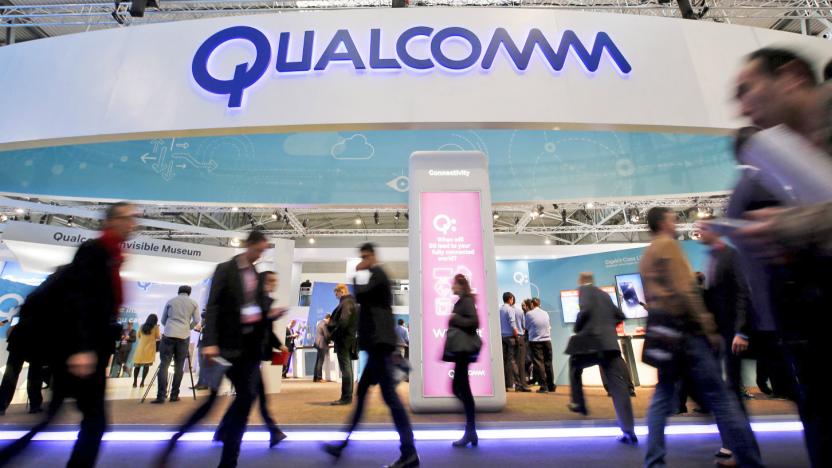snapdragon821
Latest

LG G6 ditches modularity in favor of essentials
LG's handful of recent teasers for its new G6 flagship left us wondering if there'd be any surprises left for us at its launch event today. Back in early January, the company was rather frank about moving away from the G5's modular design due to a lack of consumer interest, followed by a promise of increased safety measures after the Samsung Note 7 fiasco. While it may seem as if LG has taken a more conservative approach this time, it used three teasers to emphasize the G6's unique 18:9 "FullVision" display.

ASUS' ZenFone AR is ready for Google Tango and Daydream
The second Tango-ready smartphone has arrived -- kind of. It looks like ASUS is preparing to reveal the ZenFone AR during its press conference at CES on Wednesday, January 4th, but chip-maker Qualcomm published a blog post about the phone a few days early. According to Qualcomm, the ZenFone AR takes advantage of the Snapdragon 821 processor, which also powers Google's Pixel and ASUS' ZenFone 3.

OnePlus 3T review: A satisfying update to a fairly new phone
Remember the OnePlus 3? It came out barely six months ago and was the best phone you could get for $400. Well, it's about to be replaced by a faster, slightly more expensive version of itself that the company is calling the OnePlus 3T. (The T doesn't stand for anything; it's a cheeky take on the typical "S" suffix denoting many flagship sequels.) The new $439 device uses the latest Snapdragon 821 processor to achieve even faster speeds, and packs a beefier battery and sharper front camera -- improvements in areas where the original sort of fell short. I say "sort of" because other than battery life, the OnePlus 3 didn't need much improving. But OnePlus made it better anyway, and now it's one of the best phones on the market, especially at this price.

Xiaomi's curved Note 2 has a striking yet familiar look
It was only last month when Xiaomi launched the Mi 5s and Mi 5s Plus, but the Chinese company is already back with yet another flagship model. What we have here is the Mi Note 2 which, as you can tell by the name, is all about its large 5.7-inch 1080p display and generous 4,070 mAh battery. If it weren't for the missing stylus, you'd easily confuse the Mi Note 2 with the Samsung S7 Edge or Note 7: It comes in a familiarly gorgeous body design with curved glass on both sides, and yes, much like Samsung's offerings, the Mi Note 2 features a flexible OLED screen that lightly wraps around the edges, though it's just for looks for now. Not bad for a phone that starts from 2,799 yuan or about $413.

ASUS' Zenfone 3 and its Snapdragon 821 arrive this month
If you want the fastest Android phone in the US, you can pre-order Google's Pixel phone starting at $649, and get it around October 20th. There is another option, though -- ASUS will release its 5.7-inch Deluxe Special Edition ZenFone 3 smartphone with the same Snapdragon 821 processor in the US for $799 by the end of the month. Both have metal unibodies, but the ASUS is the flashier of the two.

Xiaomi's Mi 5s hides a fingerprint reader under its glass
We were already big fans of Xiaomi's Mi 5 flagship smartphone, so it's only natural for the Chinese company to build on this model's success by bringing us the Mi 5s. It should be no surprise that this dual-SIM device -- which has ditched the glass body in favor of metal -- packs Qualcomm's latest and greatest Snapdragon 821 chipset (as featured on the ASUS ZenFone 3 Deluxe), meaning it offers not only improved computational performance but also super speedy tri-band 4G carrier aggregation. As a bonus, it features up to 128GB of fast UFS 2.0 storage plus up to 4GB of LPDDR4 RAM, and NFC is still there on the back. But what really got our attention this time is the new under-glass ultrasonic fingerprint reader on the front.

Qualcomm's new flagship chip loads apps 10 percent faster
Qualcomm has unveiled more details about its flagship Snapdragon 821 processor that we first saw in July. It's intended to fill the gap until a future next-gen chip comes along, so performance improvements over the Snapdragon 820 (used in Samsung's Galaxy Note 7) are decent, but not amazing. CPU performance is better across the board, with boot times, app loading and overall performance up to 10 percent faster.

ASUS ZenFone 3 Deluxe gets first dibs on Snapdragon 821 chip
We knew it wouldn't be long before ASUS rolls out its latest smartphones after the Computex unveiling, but it turns out the company has saved a little surprise for us. At the Taiwan and Hong Kong launch event today, ASUS revealed that its flagship 5.7-inch ZenFone 3 Deluxe has been given a chipset upgrade -- from Snapdragon 820 to the speedier Snapdragon 821 announced yesterday. And yes, it's officially the world's first device to feature this 2.4GHz processor, while still benefiting from the same old Cat 13 LTE radio, a slightly faster Adreno 530 GPU, dual-SIM support (Micro SIM plus Nano SIM) and Quick Charge 3.0.

Qualcomm's Snapdragon 821 is its fastest processor yet
Qualcomm has revealed the Snapdragon 821, a mobile processor that's around 10 percent faster than its current performance champ, the Snapdragon 820. However, it's not a replacement for that chip, which is used in high-end phones like the Samsung Galaxy S7 Edge, HTC 10 and Sony Xperia X Performance. Rather, "the 821 is designed to complement and extend the competitive strengths" of its current tech, Qualcomm says. In other words, it'll function as an interim chip for high-end devices until the next-gen processor comes along.



